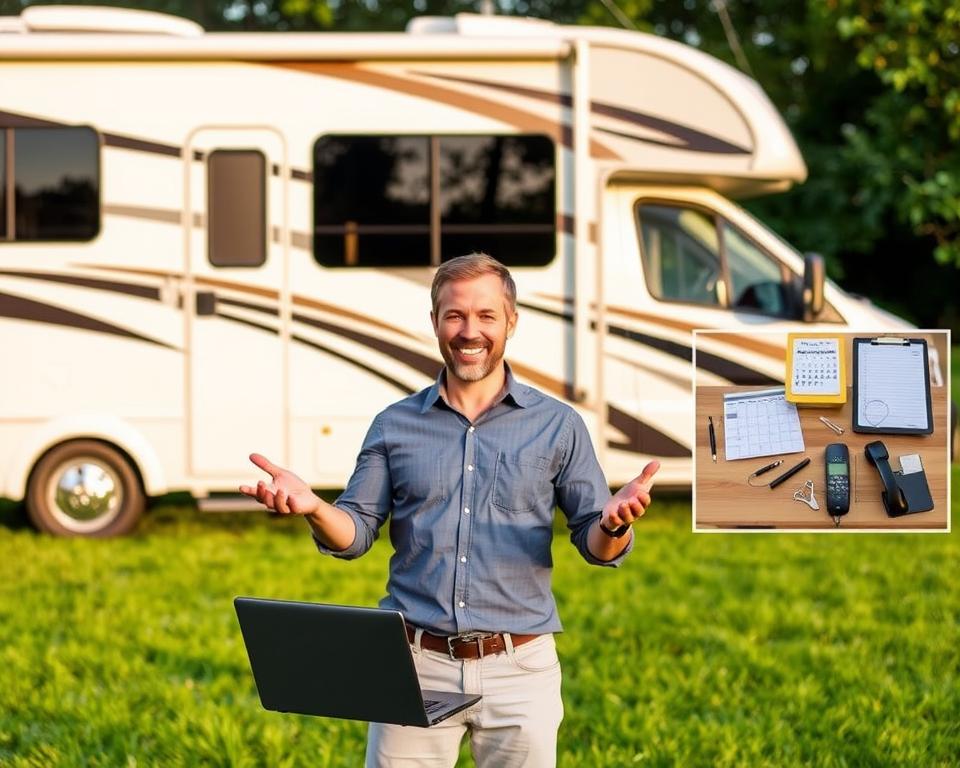RV Sewer Pump Guide: Crucial Care Guidelines
Have you given thought to the functioning of your RV’s sewer system? Knowing the ins and outs of your camper sewer pump can avoid mishaps, enriching your camping trips. It focuses on controlling waste effectively and warding off unpleasant aromas. With this manual, you’ll discover critical maintenance methods for black water pumping service. Every tip is created to sustain your waste system’s peak performance.
Comprehending Your Camper Waste Pump Configuration
The RV sewer pump system is vital for waste handling, making outdoor stays more pleasant. It comprises two principal tanks: the black water tank for toilet waste and the grey-water reservoir for water from wash basins and shower stalls. Distinguishing between these tanks is important to prevent clogs and keep your RV running seamlessly.
An camper macerator unit is a widely used solution for refuse disposal. It pulverizes solid waste into minute particles, streamlining disposal. In contrast, a classic RV pump is available. It smoothly moves waste without grinding, for those seeking a simpler option.
Understanding your RV’s sewer pump system is vital to avoiding problems and ensuring hassle-free checks. Operating the system efficiently can prevent messes, uplifting your outdoor adventures.
Why Consistent Upkeep Matters
Servicing your RV waste pump is crucial for a hassle-free adventure. Without proper maintenance, you may experience odors, clogs, or backups. These problems can wreck your road trips.
Consistent servicing prevent such complications and extend your system’s life. By checking hoses and seals, you enhance efficiency. A properly cared-for RV sewage pump secures effective refuse removal, letting you enjoy nonstop trips.
Frequent upkeep also results in financial savings over time. Neglect can cause expensive failures, requiring expensive replacements. Putting resources into regular maintenance keeps your motorhome in prime shape, saving money long term.
Recommended Frequency for RV Septic Tank Pumping
Knowing the right time to pump your RV Septic tank is crucial for its upkeep. It’s best practice to pump every 72–120 hours during use. For quick getaways, pumping on return may suffice.
Interval depends on several factors. Tank size and usage level are important. Preferably pump when it reaches two thirds. This helps ensure steady waste movement and ward off backups.
Checking your RV Septic tank capacity is key for a hassle-free trip. Oversee properly your camper’s refuse to ward off issues while traveling.

Optimal Methods for Tank Disposal
Correctly draining RV tanks is crucial for your motorhome’s sanitation and operation. Always empty first the black water tank to let the grey tank liquid rinse leftover solids. This approach prevents clogs and ensures seamless flow.
Pick a high-quality waste hose for disposal. A robust hose stops leaks and fastens connections. Use a tank rinser for a intensive cleanse, using water pressure to remove lingering waste, improving cleanliness.
Complete purging prevents residue buildup, warding off foul odors and potential issues. To maintain an optimal sewage system in your motorhome, observe these guidelines:
- Always add a tank treatment after emptying to keep odors at bay and break down waste.
- Watch capacity to avoid leaks.
- Check your RV sewer pump often for clogs and wear.
- Perform a deep tank flush every 4–8 weeks, even during occasional use.
Implementing these practices enhances your sewage system’s resilience and efficiency, ensuring memorable excursions.
Keeping Smells and Blockages at Bay
For a pleasant camping experience, warding off smells is essential. Ensure tanks have sufficient water to aid in waste breakdown, preventing unpleasant odors. Also, choosing camper-safe TP helps prevent clogs, maintaining efficiency.
For enhanced refuse control in campers, try bio-agent additives. These effectively break down waste, easing upkeep. Check the vent line often to keep air moving freely in the plumbing system.
Careful waste habits is essential to avoiding tank issues. Do not flush wipes, feminine products, and paper towels. These non-biodegradable items can cause significant obstructions. Adhering to these guidelines helps maintain a tidier camping environment.
Maintenance Advice for RV Sewage Pumps
Maintaining your RV’s sewer pump system is crucial for seamless adventures. Verify seal condition frequently to ward off leaks. Worn seals can cause accidents, harming your RV.
To eradicate odors and maintain cleanliness, sanitizing is crucial. Perform a deep clean every few months to avoid deposits, ensuring the system functions optimally. These steps are imperative for maintaining a mobile macerator, promoting durability and smooth service.
Greasing valve components is another vital task. It helps ward off seepage and improve functionality. Checking sensor accuracy is critical for accurate readings, preventing overflows and unexpected pump issues. Regularly reviewing these points makes your RV adventures neater and more enjoyable.
Indicators You Need Expert Pumping
Identifying septic problems ahead can protect you from costly repairs. A tell-tale indicator you need a expert emptying is sluggish flow. When sinks and toilets take longer to clear, it often points to clogs. It suggests your system may be backed up.
Persistent odors are another distinct indicator of sewage troubles. Unpleasant fumes hanging around despite cleaning suggest trapped waste. It’s crucial to examine the elbow trap when dumping waste. Visible residue signals it’s time for professional pump service.
Technicians use high-pressure jets to break up hard obstructions efficiently. Ignoring these warnings can escalate into major problems. Therefore, it’s vital to seek help immediately when issues arise.
| Signs of Sewage Issues | Suggested Steps |
|---|---|
| Delayed Drainage | Check obstructions; call expert service |
| Ongoing Foul Scents | Inspect fittings; schedule pump-out |
| Obvious Debris | Arrange expert emptying and cleaning |
Choosing the Right RV Macerator Pump
When choosing an RV macerator pump, evaluate its capacity, durability, and compatibility with your RV’s size. A premium macerator is vital for smooth sludge processing. This is especially true for RVs requiring frequent disposals. High-end pumps optimize sewage handling, ensuring a better travel experience.
Various units cater to different preferences. For an educated choice, focus on these main points:
- Capacity: Ensure the pump can handle your RV’s waste output.
- Durability: Choose pumps with robust construction.
- Ease of Use: Look for user-friendly pumps.
- Compatibility: Verify the pump fits your RV plumbing.
Taking time to compare when choosing an RV macerator pump enhances travel enjoyment and ensures efficient pump performance.
RV Sewer Pump Problem-Solving
Proper troubleshooting for your RV sewer pump is key in fixing common sewage issues before they worsen. If you notice lethargic outflow, unplanned backflows, or persistent odors, address promptly. These are definite clues of malfunction requiring attention.
Begin by examining the pump, its connections, and hoses. Look for any clogs that could slow flow. Ensure inlet and outlet fittings are properly connected. Also, verify the pump’s power supply for stability.
If basic checks don’t uncover the issue, listen to the pump’s sound. A unit that’s overly noisy or too quiet may have internal damage. Also, inspect for leaks, as these can magnify sewage problems. With these troubleshooting steps, many RV owners can find and resolve issues early, avoiding costly repairs.
Extended RV Pump Upkeep
For continued reliability, commit to regular sewer pump upkeep. Clean the system consistently to prevent clogs. Set up and follow a maintenance routine, keeping everyone informed of their roles. This greatly extends your waste system’s lifespan.
Training yourself and others on correct flushing habits is key. This avertss issues and fosters shared responsibility. The result benefits both users and the sewer system.
- Routine inspection of hoses and connections
- Cleaning filters regularly
- Scheduling professional servicing annually
- Using appropriate tank treatment chemicals
Abiding by these practices boosts your camper’s sewage system’s durability and keeps it healthy, making travels more comfortable.
In Closing
Caring for your RV sewer system diligently is crucial for hassle-free camping adventures. Regular attention to RV sewer system maintenance drastically lowers problem risks, letting you engage in the journey. By understanding your system and using reliable sewage methods, your trips will be free of waste management woes.
Implementing the key tips from this guide promotes RV waste management and uplifts your travel comfort and safety. Ensure pump reliability by following best upkeep practices and fixing potential issues promptly.
Keeping informed about your RV sewer system pays off. It provides homely comforts while exploring. Wishing you joyous and stress-free journeys!
FAQ
How do I know when it’s time to pump my RV Septic tank?
Service the tank at two-thirds fullness to optimize flow.
How do black and grey tanks differ?
The black tank holds toilet waste. On the other hand, the grey tank collects water from sinks and showers.
How often should I maintain my RV sewer pump system?
Perform maintenance every few months.
Which products are best for RV sewer pump care?
Choose RV-approved enzyme formulas and quality hoses and rinsers.
How to keep my camper’s sewer lines clog-free?
Avoid flushing non-biodegradable items.
What signs indicate I need professional RV pump-out?
Watch for slow drainage, recurring odors, or visible residue in the elbow.
Tips to optimize camper macerator performance?
Ensure capacity and compatibility.
What should I check during a deep clean of my RV sewer system?
Inspect all connections and hoses.
Maintaining my RV sewer system over time?
Adopt regular deep cleans and consistent sanitation.
How often should I empty my RV Septic tank with regular use?
Service tank frequently for group travel or heavy usage.
